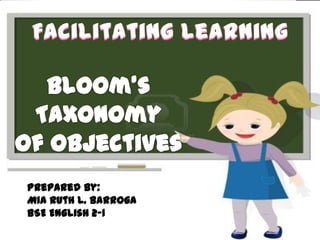Bloom's taxonomy of Objectives
•Download as PPTX, PDF•
22 likes•3,308 views
Powerpoint presentation on bloom's taxonomy of objectives
Report
Share
Report
Share

Recommended
Recommended
More Related Content
What's hot
What's hot (20)
Cognitive Domain(Bloom Taxonomy) In Curriculum Development

Cognitive Domain(Bloom Taxonomy) In Curriculum Development
Affective Domain in taxonomy of educational objectives

Affective Domain in taxonomy of educational objectives
Difference between Syllabus, Course and Curriculum

Difference between Syllabus, Course and Curriculum
Viewers also liked
Viewers also liked (20)
Similar to Bloom's taxonomy of Objectives
Similar to Bloom's taxonomy of Objectives (20)
Etr pathworks- la tarea escolar como estrategia educativa - meetings 1, 2 a...

Etr pathworks- la tarea escolar como estrategia educativa - meetings 1, 2 a...
COMPARATIVE REVIEW OF BLOOM AND SOLO TAXONOMY (https://youtu.be/r8Qj5D38GQU)

COMPARATIVE REVIEW OF BLOOM AND SOLO TAXONOMY (https://youtu.be/r8Qj5D38GQU)
Recently uploaded
Mehran University Newsletter is a Quarterly Publication from Public Relations OfficeMehran University Newsletter Vol-X, Issue-I, 2024

Mehran University Newsletter Vol-X, Issue-I, 2024Mehran University of Engineering & Technology, Jamshoro
https://app.box.com/s/7hlvjxjalkrik7fb082xx3jk7xd7liz3TỔNG ÔN TẬP THI VÀO LỚP 10 MÔN TIẾNG ANH NĂM HỌC 2023 - 2024 CÓ ĐÁP ÁN (NGỮ Â...

TỔNG ÔN TẬP THI VÀO LỚP 10 MÔN TIẾNG ANH NĂM HỌC 2023 - 2024 CÓ ĐÁP ÁN (NGỮ Â...Nguyen Thanh Tu Collection
Recently uploaded (20)
Food safety_Challenges food safety laboratories_.pdf

Food safety_Challenges food safety laboratories_.pdf
NO1 Top Black Magic Specialist In Lahore Black magic In Pakistan Kala Ilam Ex...

NO1 Top Black Magic Specialist In Lahore Black magic In Pakistan Kala Ilam Ex...
ICT role in 21st century education and it's challenges.

ICT role in 21st century education and it's challenges.
ICT Role in 21st Century Education & its Challenges.pptx

ICT Role in 21st Century Education & its Challenges.pptx
Unit 3 Emotional Intelligence and Spiritual Intelligence.pdf

Unit 3 Emotional Intelligence and Spiritual Intelligence.pdf
TỔNG ÔN TẬP THI VÀO LỚP 10 MÔN TIẾNG ANH NĂM HỌC 2023 - 2024 CÓ ĐÁP ÁN (NGỮ Â...

TỔNG ÔN TẬP THI VÀO LỚP 10 MÔN TIẾNG ANH NĂM HỌC 2023 - 2024 CÓ ĐÁP ÁN (NGỮ Â...
On National Teacher Day, meet the 2024-25 Kenan Fellows

On National Teacher Day, meet the 2024-25 Kenan Fellows
Fostering Friendships - Enhancing Social Bonds in the Classroom

Fostering Friendships - Enhancing Social Bonds in the Classroom
Plant propagation: Sexual and Asexual propapagation.pptx

Plant propagation: Sexual and Asexual propapagation.pptx
Micro-Scholarship, What it is, How can it help me.pdf

Micro-Scholarship, What it is, How can it help me.pdf
Bloom's taxonomy of Objectives
- 1. Prepared by: Mia Ruth L. Barroga BSE English 2-1
- 2. ►Is a classification of learning objectives within education proposed in 1956 by a committee of educators chaired by Benjamin Bloom ► Created in order to promote higher forms of thinking in education, such as analyzing and evaluating, rather than just remembering facts.
- 3. ►Bloom’s taxonomy divides educational objectives into three types: Cognitive(knowing/head), Affective(Feeling/heart) and Psychomotor(doing/hands) ►Bloom's Taxonomy is considered to be a foundational and essential element within the education community as evidenced in the 1981 survey Significant writings that have influenced the curriculum: 1906- 1981, by H.G. Shane and the 1994 yearbook of the National Society for the Study of Education
- 4. comes in different levels which are knowledge, application, analysis, synthesis and evaluation.
- 6. The students must recall or recognize information: facts, definitions, memorized rules, generalizations, values and skills. Verbs/Keyword: Remember Recognize Recall List State Identify Sample question stems: -Who? -What? -Where? -When? -How? -Who are the…? -What is? Sample Question: Who wrote the Noli Me Tangere?
- 7. The students understand the meaning, translation, interpolation, and interpretation of instructions and problems. State a problem and information in one's own words. Verbs/Keyword: Interpret Translate Summarize Tell Sample question stems: -What do you think could happened next? -Can you provide a definition for…? -In your own words what is …? Sample Question: Based from the article, what is the meaning of the peace?
- 8. The students use a concept in a new situation or unprompted use of an abstraction. Applies what was learned in the classroom into novel situations in the work place. Verbs/Keyword: Apply Use Show Use of facts and principles Problem Solving. Sample question stems: -How is… related to..? -Would this information be useful if…? -Why is.. Significant …? Sample Question: In what events of life can you apply this kind of method?
- 9. The students separate material or concepts into component parts so that its organizational structure may be understood, distinguish between facts and inferences. Verbs/Keyword: Analyze Separate Distinguish, Subdivide Discriminate Point out Compare Sample question stems: -Can you distinguish between…? -Classify … according to … -Make an outline for … -How does …compare/contrast with..? -What are the parts or features of …? Sample Question: What are the comparisons of these two things?
- 10. The students build a structure or pattern from diverse elements. Put parts together to form a whole, with emphasis on creating a new meaning or structure. Creating a unique or original product or proposing alternative solutions. Verbs/Keyword: Combine Compose Construct Revise Synthesize Design Plan Sample question stems: -How many ways can you ….? -What might happen if you combine…? -Can you write a new…? Sample Question: By combining the problems you gathered, can you give a possible solutions to the problem?
- 11. The students make judgments about the value of ideas or materials. Development of opinions or decisions. Verbs/Keyword: Criticize Defend Assess Justify Judge Evaluate Sample question stems: Can you defend your …? What is the most important…? Do you agree…? What do you think about…? Sample Question: Do you think Mrs. Janet Lim-Napoles can be used as state witness? Why or why not?
- 12. As teachers we tend to ask questions in the "knowledge" category 80% to 90% of the time. These questions are not bad, but using them all the time is. Try to utilize higher order level of questions. These questions require much more "brain power" and a more extensive and elaborate answer.
Editor's Notes
- ph
